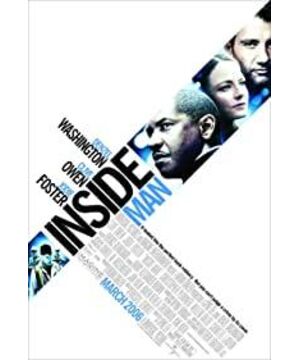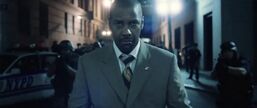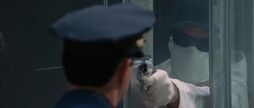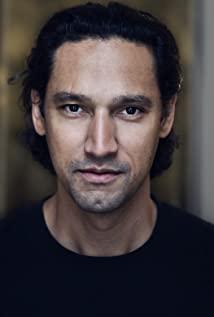It's a police movie. A group of robbers robbed the bank and seized 50 hostages. The police mobilized the forces of all parties, dispatched special police, dispatched negotiation experts, and rescued the hostages. Finally, it ended perfectly, some people were happy and some were worried.
Although it seems that the whole structure is a common hostage rescue story in Hollywood movies. In fact, otherwise, the leader of the robber confessed in the beginning of the film: "What I want to say is very important, and I won't repeat it.... Just like the great writer Shakespeare said: This is intriguing." In fact, he still said this. Twice. Perhaps the choreography is to make the audience pay more attention to the word "intriguing".
Let's take a look at this way of taking hostages from the bank. It is indeed surprising and intriguing. According to the usual thinking, a group of masked robbers broke into the bank and yelled: "Stop talking nonsense, robbery!" , Full. Then ran away, and the police and gangsters dragged their cars. The robber who runs fast wins, and the policeman who runs slowly wins. This is not the case in this movie. The robbers have three steps, one is not killing a person, and not grabbing a penny. It just opened safe No. 392, took away key documents and a bunch of diamonds. And this number 392 is precisely not recorded in the bank's files. The second is that the robbers, bank employees, and customers uniformly wear uniforms so that the police can be confused when they escape, and they can't figure out who is the common people and who is the Balu. The third is to spend time with the police slowly. The robbers used this time to rush the sledgehammer to decorate and build a secret room in the bank warehouse. Even the pit was dug. In the end, as the robber leader said, "walking out of the bank swaggeringly through the gate", he hadn't forgotten to slip a diamond into the police detective's pocket.
Take a look at the "insider" approach, which is equally intriguing. The so-called "insiders" are people of all kinds who are directly related to this robbery. In addition to the immediate situation directly related to them, it also involves various other interests. Therefore, behind the handling of this case in accordance with the procedures in the eyes of outsiders, there are many hidden rules and behaviors that are not known.
Madeleine, the political broker, deals with the upper class, using their various weaknesses for their own benefit. She helped the banker Arthur Case find the document. In addition to the remuneration, Case had to guarantee Bin Laden’s son to buy a house. She also made the case close as soon as possible through the mayor’s relationship. In this way, the exchange of interests between them was completed.
Negotiation expert Fraser is an upright and dedicated policeman. Although he is undergoing a corruption investigation, he did not hesitate to go to the scene to participate in the hostage rescue. He said to the kidnapped hostages: "I swear to save you all. "Perhaps it was this that moved the kidnappers, and finally left the largest Cartier diamond in the safe, and told him: "Follow the diamond." Let Fraser understand that the banker Case is also unclean. At the end of the film, Frazier raised his middle finger to Case, with the diamond ring on his middle finger. There is mockery and warning. Makes Fraser successfully promoted to senior police officer.
Robber leader Russell is clever and sophisticated, and orchestrates the bank robbery. His motives are twofold, one is for money; the other is out of a sense of justice, so-called stealing is also right. For future safety, he took away the top-secret document so that he could threaten and blackmail Kelly if he encountered danger in the future.
The banker Kelly made his fortune by colluding with the Nazi Party to extract Jewish property during World War II. The famous saying he believes in is: As long as the joint is bloody, start investing. Like most businessmen, he puts the principle of "maximum benefit" above the moral law. The Cartier diamond once belonged to a wealthy Jewish merchant family that Kelly used to befriend with, because the conditions offered by the Nazi Party were too good. Under the temptation of money, he watched all the Jewish family die in the Nazi concentration camp. After that, he also tried to atone for his sins and did many good deeds to the society. However, none of this was enough to conceal the filthiness of his soul. As long as he betrayed his soul once, he would forever nail himself on the pillar of moral shame.
The last insider appeared at the end of the film. In the back seat of the car that received Russell, there was a Jewish rabbi. It is undoubtedly the mastermind behind this bank robbery. Perhaps all the information about Kelly and his bank was provided by him. After all, Israel’s Mossad’s intelligence work is well-known in the world. As the Jews who suffered in World War II, avenging the Nazis and those related to them is always an important part of their lives. When it comes to revenge, it does not necessarily mean sending the enemy to prison or shooting him. That would be too cheap for them. This Jew must have been familiar with Dumas's "Count of Monte Cristo". He knows that the best way to get revenge is to grasp the enemy's most critical handle and choose what he cares most about. For Kelly, what he cared about most was his money and the evidence of his collusion with the Nazis. Once you get it, you don't need to show it to the public, but similar to our previous method, "don't wear a hat to him, take the hat in the hands of the group." Incited but not sent, Kelly lived in fear for the rest of his life, life is better than death. This is the best means of revenge.
For these insiders, not only in the United States, but wherever there are people, these unspoken rules are generally operating, quietly opposing social justice and injustice, opposing majestic and weak laws, and opposing people’s Morality and conscience. Manipulating and mastering the kindness of most outsiders. Even in today's highly developed civilization, we still cannot clear the darkness that shouldn't exist. We ourselves sometimes even become such insiders unconsciously. Among them, there are despicable and shameless, but also helplessness and hatred.
For those outsiders in the play, although the director does not focus much on the outsiders, they have their own characteristics. They prefer to accept death rather than accept the humiliation of the old woman, proudly claim that they are from Brooklyn, the black child playing games, and would rather be scolded as a race. Discriminators are also unwilling to kill the police for no reason, the Indian Sikh man with a turban, the old man who is worried about television when he escapes from the danger, and the Albanian woman who doesn't suffer. All these beings outline the basic face of New York society.
My score: 7.5.
View more about Inside Man reviews











